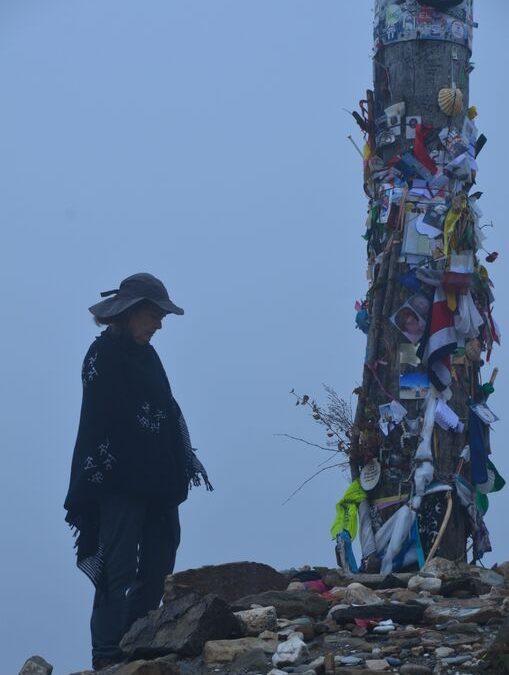The air in the waiting room at the Bilbao International Airport pressed against us, dank and heavy. A greasy stench rose from a counter loaded with plastic containers of Spanish omelets.
“Where are they?” I asked, looking around the room.
In the far corner, a group of young men, all wearing identical yellow and black T-shirts displaying an image of a large soccer ball, slapped each other on the back and exchanged high and low fives, as though celebrating an important victory. In the center of the room, people chatted with one another as they stood in line in front of the omelet counter.
Then we spotted the group we were looking for.
Ten months earlier, Ed and I had stumbled across Brad’s Illuminated Journeys website. Captured by the photographs, we scanned the details about the upcoming pilgrimage he was leading on El Camino de Santiago, also referred to as The Way. We knew very little about the Camino, other than what we’d seen in Martin Sheen’s 2010 movie. And we knew nothing about Brad. But something compelled us to sign up.
“Hi, I’m Ed,” my husband said, reaching to shake Brad’s hand. “And this is Marlena.”
“Welcome to Spain,” Brad said, squeezing my hand. “Here, let me introduce you to the rest of the pilgrims.”
Pilgrims from around the world walk the Camino from points throughout Europe to reach the tomb of Saint James in a town in northern Spain called Santiago de Compostela. There are many reasons people take the journey. Simply to walk. To search for meaning in their lives. To find silence. To do penance. To give thanks. Or to let go of a burden the pilgrim is willing to leave behind at the Cruz de Ferro, a simple iron cross atop a thirty-foot, weathered, wooden mast that marks the highest point of the Camino. It’s surrounded by a hill of stones amassed through the centuries by pilgrims performing spiritual “letting-go” rituals there. They bring a stone from their homeland that symbolizes a burden they wish to release, and add it to the mound.
I wasn’t at all sure why we were there. It seemed like a fun idea when we signed up. Surely it was a good way for us to experience the Camino, traversing only those portions of it that an expert had identified for us in advance. The entire Camino begins at Saint Jean Pied de Port, France, and continues for over 500 miles through four of Spain’s 15 regions, ending at the Catedral de Santiago de Compostela in Galicia. We would walk only the parts that Brad felt were the most interesting or important. And at the end of each day, a luxurious coach would wait to take us to comfortable lodging and food for the night.
Two months ago, however, Brad had sent us a question that suggested we were in for something more than a mere walk through the Spanish countryside.
When we get to the Cruz de Ferro, what will you let go of?
For many weeks, I had pondered his question. I’d tried out many answers. I could let go of sugar for an entire year, I thought. Or red meat. Or wine. Or I could empty out half of my clothes closet, give the stuff away.
Each time I came up with another thing I could let go, I heard Brad’s words, willing me not to trivialize this. Prodding me to make this count. Why do I even care what this Brad guy wants me to let go of, I thought. I don’t even know him, and he certainly doesn’t know me.
On our flight to Spain, I still hadn’t found an answer to Brad’s question. I picked up a stone from the white-water river that flowed in front of our home in Oregon, and tucked it into my suitcase, just in case. But I had no idea what burden it should symbolize. I frowned at the insistent voice in my head. What are you willing to let go of?
I turned to my husband in the seat beside me. “How’d you get yours so fast, Ed?” “I mean, I get the feeling Brad wants us to do something life-changing by that cross. How did you know what to choose?”
Ed was silent for a moment. “Have you thought about it like this?” he finally said. “Have you thought about the thing you like least about yourself? You could start there and work on letting that go?”
As our plane flew across the Atlantic, I made a long list of things I disliked about myself.
I am often judgmental.
I am sometimes harsh.
I can be impatient.
I am often judgmental.
I am a perfectionist.
I am often judgmental.
I am often judgmental.
And so I identified it. And the jagged stone from the wild and untamed McKenzie River was a perfect symbol of my harsh judgments. I even found and memorized a short list of meditations that I hoped would help me on my journey.
I consciously give meaning to and bless whatever happens to me.
I know that there are no negative or positive events, people or situations in life. They’re all my teachers.
I welcome, accept, celebrate and express gratitude for everything that occurs in my life.
I breathed in a prayer of surrender as I introduced myself to Brad’s pilgrims. They’re all my teachers.
I listened to their introductions. There were quite a few Baptists, some of them ministers, two Mennonites, a Catholic priest, and to my surprise, a lesbian. It seemed to me that our reasons for being there covered pretty much the full spectrum. I wonder what they’re letting go of, I thought, eyeing the Mennonites suspiciously.
Breathe.
We began our walk on the Camino by climbing the Alto de Perdón, the Mount of Forgiveness. It was a winding trek up the hill against a stiff wind.
At the top of the hill, a long row of metal statues stood tall against the deep blue sky. They represented pilgrims who had braved the wind to continue on the path. Many had passed here before and many would pass here in the future. I pulled my cap down low to protect my ears against the stiff wind and looked toward the west where the Camino wound its way toward the goal. I consciously give meaning to and bless whatever happens to me, I murmured to myself, wrapping my fingers around my rock.
For a number of days, we walked through the beautiful regions of Navarra, Rioja, and León, meeting pilgrims of all ages and nationalities along the way. We trudged along paved highways full of deep potholes, which abruptly turned into narrow trails. Steep mountain trails became flat stone-strewn roads with sloping meadows. We made our way through open fields and then moved into thick groves of oak trees hugging the trail, their branches hanging close to the ground. We passed through small villages with ancient stone buildings disintegrating in the wind.
“Buen camino,” we pilgrims said to one another as we passed, which literally means “good road.” We learned that it also has a deeper meaning, an acknowledgment that you wish people well in pursuing their pilgrimage intent. With nearly every “buen camino,” I touched the rock in my left pocket and breathed in one of my meditations, welcome, accept, celebrate and express gratitude…
A deep fog enveloped the path on the fifth day of our pilgrimage. This was the day I’d been waiting for. My rock, which I’d now removed from my pocket and held in my hand, seemed to get heavier with every step. Slowly and quietly we walked the country road in the mist, passing groups of cows and patches of heather. I could feel the grade increasing, straining the backs of my legs as we ascended the pass of Irago. When we reached the crest of the pass, the mountains to the south appeared in heavy bulges and huge white wind turbines peaked through the dense fog.
There it stood. I’m not a religious person, but the gaunt wood pole with the iron cross on the hillside in the low-hanging clouds reminded me of the Bible story about Golgotha. Tears began to sting my eyes as I stood still and gazed up at the cross.
I was prepared for this moment. When it was my turn to climb the hill of stones, I held my rock gently against my heart. The stones shifted and clinked under my feet. With something close to reverence, I blessed this mountain of stones, each one a symbol of a burden a pilgrim wanted to leave behind before leaving the Cruz de Ferro and beginning life anew. Some stones had messages written on them, others the names of towns or people. Some had paper notes or photos tied to them, others stuffed bunnies or bears.
When I reached the base of the mast, I looked up along its length through the heavy fog. There, high above my head, a tiny ray of sun found a crack and touched the iron cross. I knelt at the base and pressed my forehead against the wood, tears streaming down my face. Ever so gently, I placed my rock, the weight of a lifetime of judgments, on the pile between a stone with a heart painted on the face of it and another stone with Elena printed on it in long, slanted letters.
As I stood up and turned, I caught sight of a small crowd of bicyclists at the foot of the hill, taking pictures of one another with the cross as a backdrop. They raised cans of beer high in the air and with loud cheers they toasted their arrival at the Cruz.
I felt my chest constrict as rage began to flare. Couldn’t they see that they were rudely disturbing a sacred spot?
I turned toward the cross, towering behind me against the gray sky, and then back to the cheering bicyclists. My chest expanded as I gradually let go of my rage and inhaled a deep sense of oneness. In that moment, I understood that this was not the culmination, but rather the beginning of my journey toward greater peace in my life.
“Buen camino.” A pilgrim, eyes shimmering with tears, smiled brightly at me as he passed me on his way up to the cross.

